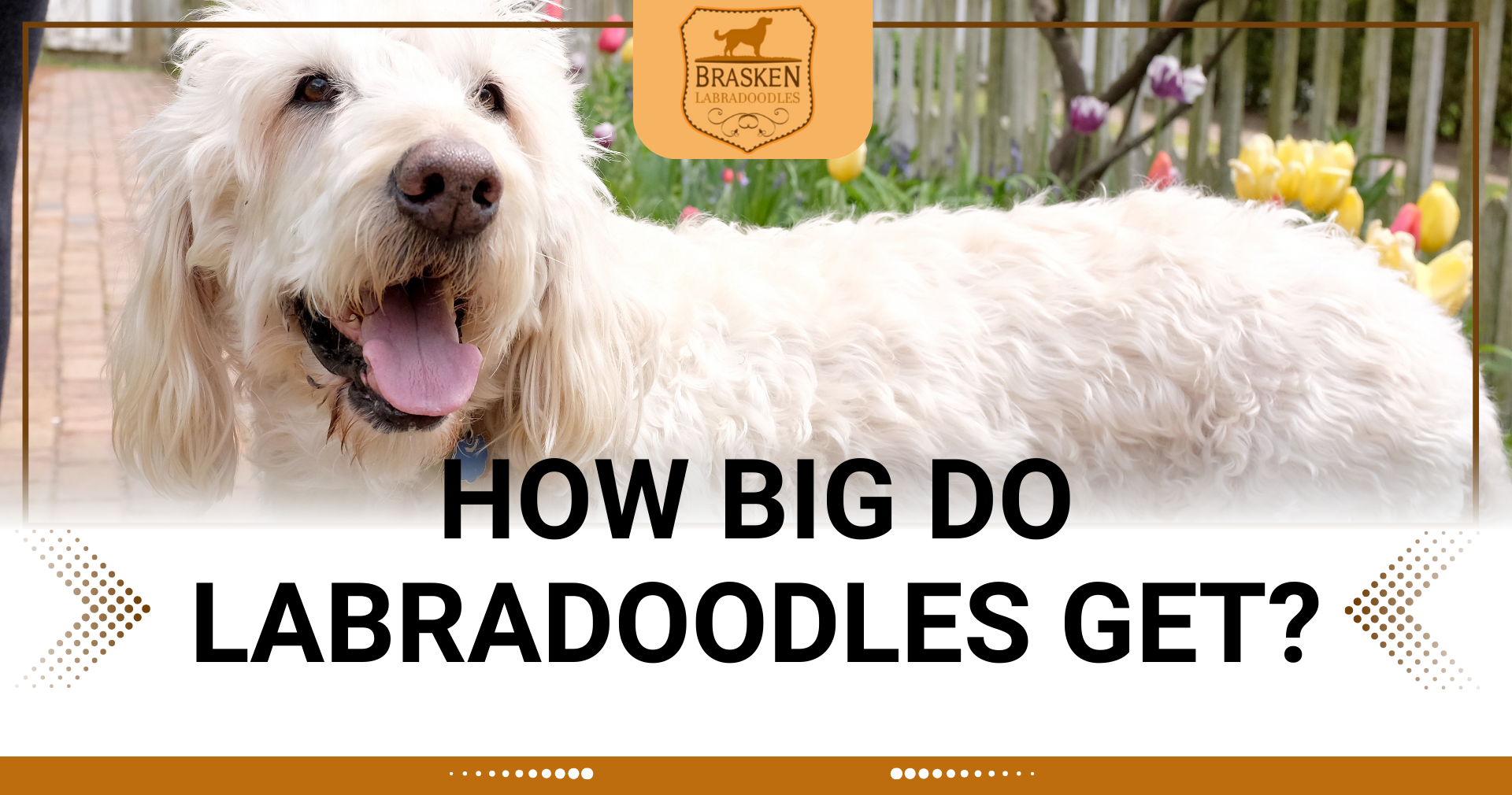Loyal, affectionate, and supremely intelligent, Labradoodles have all the traits that make for the perfect lifelong companion.
As one of the best dogs one can get, these adorable creatures love to please their owners.
However, one problem is that these dogs could get a lot to handle if they’re too big for what you expect. So, how big do Labradoodles get?
Getting the right-sized Labradoodle that fits your lifestyle is a vital consideration for many reasons, and that’s also what we will go over in this post. Read on!
Labradoodle Overview
Labradoodles originated in the 1980s in Australia when Wally Conron, a breeder working for the Royal Guide Dogs Association of Australia, crossbred a Labrador Retriever with a Standard Poodle.
The purpose behind creating this mixed breed was to create a hypoallergenic guide dog for visually impaired people. Conron aimed to create a hybrid dog with the Labrador’s gentle temperament and high intelligence with the low-shedding coat of the Standard Poodle.
This initial breeding resulted in a litter with puppies having varying coat types and personalities, leading to what we know as the Labradoodle today. Some had curly coats similar to Poodles, while others had straight or wavy coats like Labradors.
The offspring also had different temperaments, so it was clear that the Labradoodle puppy was likely to be unpredictable. Although most of them were docile.
The success of this crossbreeding experiment in producing a hypoallergenic Labradoodle dog led to increased interest in these canines, both as service dogs and as family pets.
The breed’s popularity grew steadily, particularly as more people sought companion animals suitable for allergy sufferers.
Breeders also worked to establish standards and variations within the breed, attempting to create more predictable traits in terms of size, coat, and temperament.
But it’s not that simple!
Labradoodle Size Variations
Labradoodles can vary significantly in size, which is influenced largely by the size of the Poodle parent.
The following is a breakdown of the size variations typically associated with the Labradoodle breed:
Standard Labradoodle
A standard Labradoodle is a mix between a Labrador and a standard Poodle. These Labradoodles are typically the largest, with adult dogs usually weighing between 50 to 80 lbs and standing around 21 to 24 inches tall on average.
Medium Labradoodle
The medium Labradoodle is a cross between the Labrador and the medium Poodle. The result is a dog somewhere in the middle in terms of size. They usually weigh between 30 to 50 pounds and stand about 17 to 20 inches tall on average.
Miniature Labradoodle or Toy Labradoodle
Breeding a miniature Poodle with a Labradoodle results in a mini Labradoodle. If the parent is not a toy poodle, it will likely be a slightly bigger dog when it reaches the age of an adult Labradoodle.
The petite Labradoodle typically weighs around 15 to 30 pounds and stands approximately 14 to 16 inches tall on average, according to the breed standard.
Teacup Labradoodle
This variation occurs after breeding the smallest dogs over various generations, resulting in the smallest Labradoodle size.
These dogs typically weigh less than 15 pounds and stand about 9 to 11 inches tall on average, smaller than miniature Labradoodles.
It’s important to note that while these size ranges are generally associated with Labradoodles based on the size of the Poodle parent, variations within each category can still happen because of their particular genetics and other factors. So, considering the size of the individual parent dog is extremely important here.
That’s why it’s always best to consult with reputable Australian Labradoodle Association breeders who can provide more specific information about the size expectations for their particular breeding lines and ensure that the labradoodle pup matches the defined standards.
Labradoodle Generations (F1 vs F1B vs F2)
The different generations of Labradoodles are categorized based on the generations of their parentage, particularly concerning the Poodle lineage.
Here’s a breakdown for this dog breed:
F1 (First Generation)
F1 Labradoodles are produced by crossing a purebred Labrador Retriever with a purebred Poodle. They have a 50/50 mix of both parent breeds. As an equal mix of both, these dogs tend to have a wider range of traits and can vary significantly in size, coat type, and temperament.
They can shed as little as the Poodle or as much as the Labrador. Likewise, an F1 Labradoodle can have a hair or fleece coat instead of the Poodle’s hypoallergenic wool coat.
F1B (First Generation Backcross)
F1B Labradoodles are created by breeding an F1 Labradoodle with a purebred Poodle.
This generation is often favored for its increased hypoallergenic qualities, as they have a higher percentage of Poodle genetics.
F1B Labradoodles are more likely to have non-shedding coats and can be smaller in size than the standard Labradoodle due to the dominant Poodle influence, which is about 75%.
F2 Labradoodle (Second Generation)
F2 Labradoodles result from breeding two F1 Labradoodles. Their traits are less predictable compared to F1B Labradoodles because the genetic combination is less consistent.
However, They have the highest Poodle traits, which means they are likely to be smaller than the F1 and FB Labradoodles while shedding the least as well.
Factors Influencing Labradoodle Size
As with most dogs, several factors can help determine how big your Labradoodle can grow. These mainly include:
Parentage
The size of the Labradoodle is significantly influenced by the size of the Poodle parent. Standard Poodles will generally produce larger Labradoodles, while miniature or toy Poodles will result in smaller variations of the breed comparatively.
There’s also a cross with other dogs, like The Australian Labradoodle. This dog, originating in Australia, is a specialized type of Labradoodle.
It is a result of careful breeding involving Labrador Retrievers and Poodles, but also other breeds like a Cocker Spaniel to refine traits.
To get the best idea about your puppy’s expected size, discuss the height and weight of the parent breed with the Labradoodle breeder. A good rule of thumb is that your dog will fully grow to be the average of both parents’ size.
Generation
As mentioned, different generations (F1, F1B, F2) can impact Labradoodle size. F1Bs and subsequent generations with more Poodle lineage result in smaller sizes due to higher levels of Poodle genes.
Diet
Nutrition plays a vital role in a canine’s overall development, including its size. Proper nutrition, including a balanced diet suitable for the specific life stage of the Labradoodle, can contribute to healthy growth. Overfeeding or underfeeding can potentially affect the dog’s size and overall health.
Gender
In most cases, gender can play a role in size, with a male Labradoodle generally being slightly larger than a female Labradoodle. However, this difference may not be as pronounced in all individual dogs.
Importance of Getting the Right-Sized Dog?
Choosing the right-sized Labradoodle for your family and lifestyle is crucial for various reasons:
Exercise Needs
Different-sized dogs have varying exercise requirements. Larger breeds like Labradoodles may need more space and longer walks or vigorous play sessions to expend energy. If their exercise needs are not met, it can lead to behavioral issues or health problems.
If you can’t commit to providing regular exercise each day, a standard or medium Labradoodle might not be the best fit for you. However, it is crucial to note that even a miniature labradoodle might need the same levels of exercise and activity each day.
Space
The size of your living space matters when getting a dog. Smaller homes or apartments might not provide enough room for larger dogs to move around comfortably. Ensuring your dog has adequate space to live and play is essential for their well-being. A studio apartment might not be the best choice to house a standard Labradoodle.
Age of Children
When selecting a Labradoodle, considering the ages and sizes of children in the household (if any) is vital. Larger dogs are capable of unintentionally knocking over or overpowering toddlers or small children, making smaller Labradoodles a viable choice in this situation.
Nutrition
Dogs of different sizes have different dietary needs. Larger dogs may require more food and specific nutritional requirements tailored to their size to maintain optimal health. Conversely, smaller dogs may need smaller portions and different nutritional balances.
An adult standard or medium Labradoodle can consume up to 1500- 2000 calories per day, while the miniature Labradoodle requires lesser amounts.
Finding the right-sized dog that fits your lifestyle, living environment, and the dynamics of your family is essential. It ensures the dog and the family members can have the best chance at a great life and a long-lasting bond for the time to come.
With all the right information in hand, you can create a suitable and comfortable environment for your furry friend to thrive physically and emotionally.
Conclusion
Labradoodles can vary widely in size, mainly due to factors like their Poodle parent’s size and generation. However, most standard Labradoodles weigh about 50 to 80 lbs with a height of up to 24 inches. Miniature and medium Labradoodles stand up to 16 and 20 inches tall, weighing upto 30 lbs and 50 lbs, respectively.
Getting a dog is a lifetime commitment. Therefore, choosing the right-sized Labradoodle is at the core of living comfortably and happily for you and your dog. It mainly involves considering your living space, ability to provide regular exercise, and compatibility with family dynamics.
ABOUT BRASKEN LABRADOODLES
For almost two decades, Brasken Labradoodles has been recognized by the ALAA as one of the best Labradoodle breeders in California. The dedication of Kristin & Brandon to the well-being and care of their Labradoodles showcases their passion for these affectionate and intelligent animals, ensuring each puppy is raised with love and expertise. Their commitment reflects in the healthy, happy, and well-socialized puppies that become cherished members of their new families.

